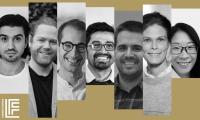Eight promising young researchers receive Lundbeck Foundation Fellowships

Supported by a Lundbeck Foundation Fellowship worth 10 million Danish kroner, eight dedicated researchers can now spend the next five years devoting themselves to their research. Almost half of the projects are within the field of neuroscience.
This is the fourteenth time the Lundbeck Foundation is awarding fellowships and, yet again, the recipients are young yet well-established researchers, and they will now have the chance to establish their own research group.
‘Our Fellowship programme is all about stimulating talent and developing the careers of young researchers. The projects cover a broad spectrum, but all have the potential to radically transform our understanding of their field,’ says Jan Egebjerg, Director of Research at the Lundbeck Foundation.
He is particularly pleased to note that three of this year’s eight fellowships are within the field of neuroscience:
‘One in three Europeans suffer from a disease of the central nervous system, and with an ever-ageing population, the human and economic costs are bound to increase in the future. Therefore, there’s a growing need for research-based insight into the complexity of the brain. And in this context, it’s positive that, this year, almost half of the most qualified applicants for our Fellowship programme work in the field of neuroscience,’ he says.
The eight Fellows are:
Jannick Prentø, Department of Immunology and Microbiology, University of Copenhagen
Scientists around the globe have tried in vain to design a vaccine for HCV (the hepatitis C virus). However, the proteins on the surface of the virus can take on a variety of shapes, making it difficult to identify how the virus infects the body. Jannick Prentø has been focusing on HCV for a number of years and his Lundbeck Foundation Fellowship will allow him to dedicate more of his time to gaining a better understanding of the HCV virus’s extraordinary ability to change shape. The aim is, in time, to develop a vaccine.
Bjarni Vilhjalmsson, The National Centre for Register-based Research, Aarhus University
With its anonymised health data, social data and information about the DNA of 130,000 Danes born between 1980 and 2005, the iPSYCH database is a unique treasure trove of knowledge. Over the next five years, Bjarni Vilhjalmsson will attempt to develop an analysis tool able to handle the many different types of data so that scientists can glean as much new knowledge as possible about psychiatric disorders such as schizophrenia and depression.
Sandra Breum Andersen, Department of Biology, University of Copenhagen
Basing her research on the Helicobacter pylori bacterium – probably better known as the stomach ulcer bacterium – Sandra Breum Andersen will study how bacteria and people interact. In addition to being one of the causes of stomach ulcers, the bacterium plays a role in the development of stomach cancer. On the other hand, it has also been proven to protect against cancer of the oesophagus and development of asthma and allergies. Among other things, Sandra will investigate whether the bacterium could provide some protection against malaria and obesity.
Joseph Lyons, Department of Molecular Biology and Genetics, Aarhus University
Lipid transport in the cells of the body is important for a wide variety of basic biological processes, such as blood coagulation. Any dysfunction in this process could therefore have a significant impact and, among other things, lead to an accumulation of misfolded proteins – plaques – as seen in patients with neurodegenerative disorders such as Alzheimer’s and Parkinson’s diseases. Using cryo-electron microscopy, Joseph Lyons will study how lipid transport works down to the atomic level.
Andrew Schork, Institute for Biological Psychiatry, Mental Health Services in the Capital Region of Denmark
Andrew Schork will investigate whether large volumes of health data and DNA-based analysis tools can help us develop so-called genetic risk profiles that will give an educated estimate of an individual’s risk of developing mental disorders. The objective is to provide better therapies, tailored to the individual patient. However, it is also a question of prevention. If a risk profile can tell us whether we are genetically predisposed to developing a particular disease, there may be things we can do ourselves to prevent outbreak of that disease.
David Olagnier, Department of Biomedicine, Aarhus University
Many cancer cell lines are highly resistant to both chemotherapy and radiation treatment. However, a new therapy is currently under development. This new treatment uses a genetically modified virus – a so-called oncolytic virus – to fight cancer cells. The virus acts like a “precision missile” and penetrates and destroys the cancer cells without causing damage to healthy tissue. Focusing on prostate cancer and lung cancer, David Olagnier will spend the next five years researching this oncolytic-virus therapy.
Alexander Rauch, Department of Medical Endocrinology, University of Southern Denmark
One in two women and one in five men will suffer a broken bone due to osteoporosis at some time during their lives. Alexander Rauch will spend the next five years studying the biology underlying this disease in order to gain a better understanding of the bone marrow stem cells that promote bone regeneration. This knowledge could, for instance, be useful when designing cell therapy for treating osteoporosis, and it may in time also help identify prophylactic treatments for the disease.
Thomas Stiehl, Department of Science and Environment, Roskilde University
The great challenge of leukaemia research – particularly the so-called chronic myeloproliferative neoplasms and acute myeloid leukaemia – lies in the fact that the biological processes of the disease mainly take place in the bone marrow. Since it is not possible to study these processes directly, Thomas Stiehl will attempt to construct mathematical models to enable researchers to study them indirectly. Among other things, the models will be used to test a range of hypotheses, e.g. about cell division and cell maturation and how cells react to various types of therapy.
For further details please contact:
Jan Egebjerg, Director of Research at the Lundbeck Foundation, tel. +45 3912 8009 or je@lundbeckfonden.com
Pernille Thorborg Jasper, Media Relations Manager at the Lundbeck Foundation, tel. +45 2118 9132 or ptj@lundbeckfonden.com










